4.5- Homeostasis and Response
1/124
There's no tags or description
Looks like no tags are added yet.
Name | Mastery | Learn | Test | Matching | Spaced |
|---|
No study sessions yet.
125 Terms
Define homeostasis
Homeostasis is the maintenance of a constant internal environment, in response to internal and external changes, for the maintenance of optimum cell and enzyme function.
State three functions controlled in homeostasis
1. Blood glucose concentration
2. Body temperature
3. Water levels
Name two automatic control systems in the body
Nervous control
Chemical control (hormonal)
Where in our bodies are receptors found?
In the sense organs, eg, skin, eyes, ears, nose
What is meant by the term ‘reflex action?’
An automatic response that does not involve thinking, is not conscious or is involuntary
State the order of a reflex action
Stimulus, receptor, sensory neuron, central nervous system (relay neuron), motor neuron, effector, response
Name two parts of the body that are effectors and bring about a response
Muscles and glands
State the name of the neurons that conduct electrical impulses from the central nervous system to the effectors
Motor neurons
State the name of the neurons that conduct electrical impulses from the receptors to the central nervous system
Sensory Neurons
State which two parts of the body make up the central nervous system
Brain and spinal cord
A person steps on a pin. Describe the reflex action that brings about a response.
The pain is detected by the receptors in the skin. An electrical impulse is conducted through the central nervous system (in this case, the spinal cord), through the relay neurons and to the motor neuron. When the electrical impulse arrives at the axon terminal of one neuron a chemical neurotransmitter diffuses across the gap (called a synapse) which binds to the second neuron and stimulates another electrical impulse. The impulse is conducted to the effector - in this case the muscles in the foot and leg. These muscles contract and bring about the response which is to move the leg away.
True or false - Reflex actions are slow and conscious
False - reflex actions are fast, short lived, automatic and not conscious
True or false - reflex actions are automatic
True
State two examples of human actions that are reflexes
Removing your hand when touching a hot object, blinking when a light flashed
Name three types of neuron
Sensory neuron, relay neuron, motor neuron
Which type of neuron is found in the central nervous system (CNS)
Relay neuron
In what form are ‘messages’ conducted through the nervous system?
Electrical impulses
Name the extended cell membrane on a neurone
Axon
State the name of the structures that surround the axon on a neurone
Myelin sheath or fatty sheath
State the function of the myelin sheath (fatty sheath)
To speed up electrical impulses
To insulate the neurone from neighboring neurones
State the name of the gap between neurones
A synapse
State factors that can increase reaction time
Alcohol, drugs, tiredness, age, distraction
State factors that can decrease reaction time
Practice, caffeine
Electrical impulses cannot cross a synapse. Describe the mechanism used instead
When the electrical impulse reaches the axon terminal a chemical neurotransmitter is released into the gap (synapse). The chemical then moves across the synapse by a process called diffusion. Once the neurotransmitter reaches the second neuron it binds to receptors which stimulate an electrical impulse in the second neuron. The neurotransmitter diffuses back across the synapse and is reuptaken into neurone 1
State the name of the chemical that diffuses across a synapse
A chemical neurotransmitter e.g serotonin
What do muscles do to bring about a response?
They contract
Draw and label the parts of the brain
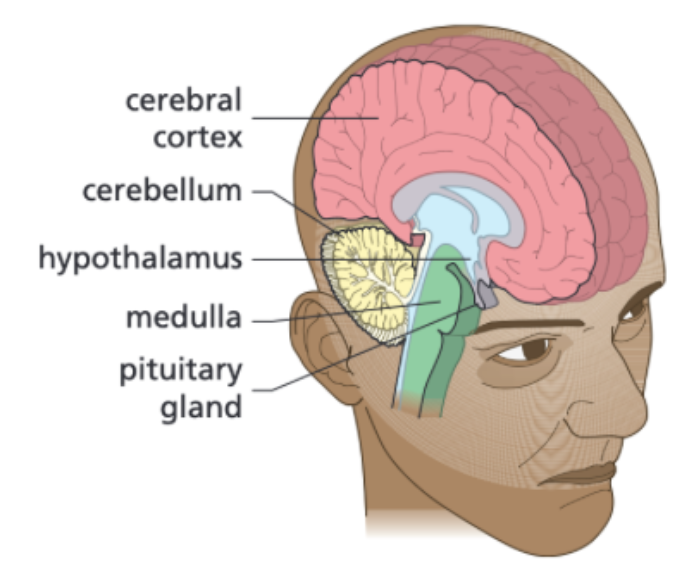
What is the role of the cerebral cortex
The cerebral cortex is concerned with consciousness, intelligence, memory and language
What is the role of the cerebellum
The cerebellum is concerned with coordinating muscular activity and balance
What is the role of the medulla
The medulla is concerned with unconscious activity, such as controlling heartbeat, the movement of the gut, and breathing
What is the role of the hypothalamus
The hypothalamus is involved in controlling body temperature
What is the role of the pituitary gland
The pituitary gland releases various hormones and plays a part in coordination and control of body systems
Why is it difficult for scientists to investigate brain functions
The brain is very complex and delicate
Many of the processes that take place involve lots of different neurones in different places
There is range of different molecules released in the synapses of the brain
The brain is easily damaged/destroyed
Why is it difficult for scientists to treat brain disorders and diseases
Drugs do not always reach the brain through the membranes that surround it
Surgery is difficult because it isn’t fully understood what every region of the brain does
We may cause unintended harm
How have neuroscientist mapped parts of the brain
Neuroscientists have been able to map the regions of the brain to particular functions by studying patients with brain damage, electrically stimulating different parts of the brain and using MRI scanning techniques.
Draw and label the parts of the eye
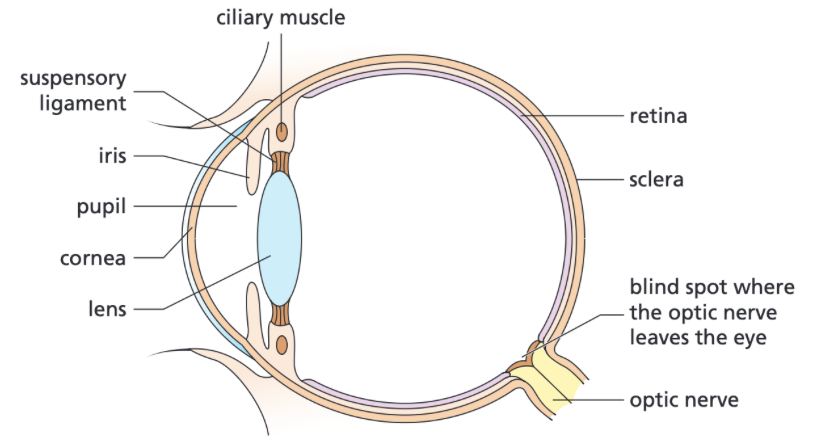
What is the role of the sclera
The sclera is the white outer layer of the eye- it is relatively tough and strong so the eyeball is not easy to damage
What is the role of the cornea
The cornea is the transparent area of the sclera at the front of the eye- this lets light into the eye. The curved surface is important for changing the direction of light rays coming into the eye, helping to focus them onto the retina
What is the role of the pupil
The pupil is the hole in the eye through which light enters the eye
What is the role of the iris
The iris is made of muscles which contract or relax to change the size of the pupil, to control the amount of light which hits the retina
What happens in dim light

What happens in bright light
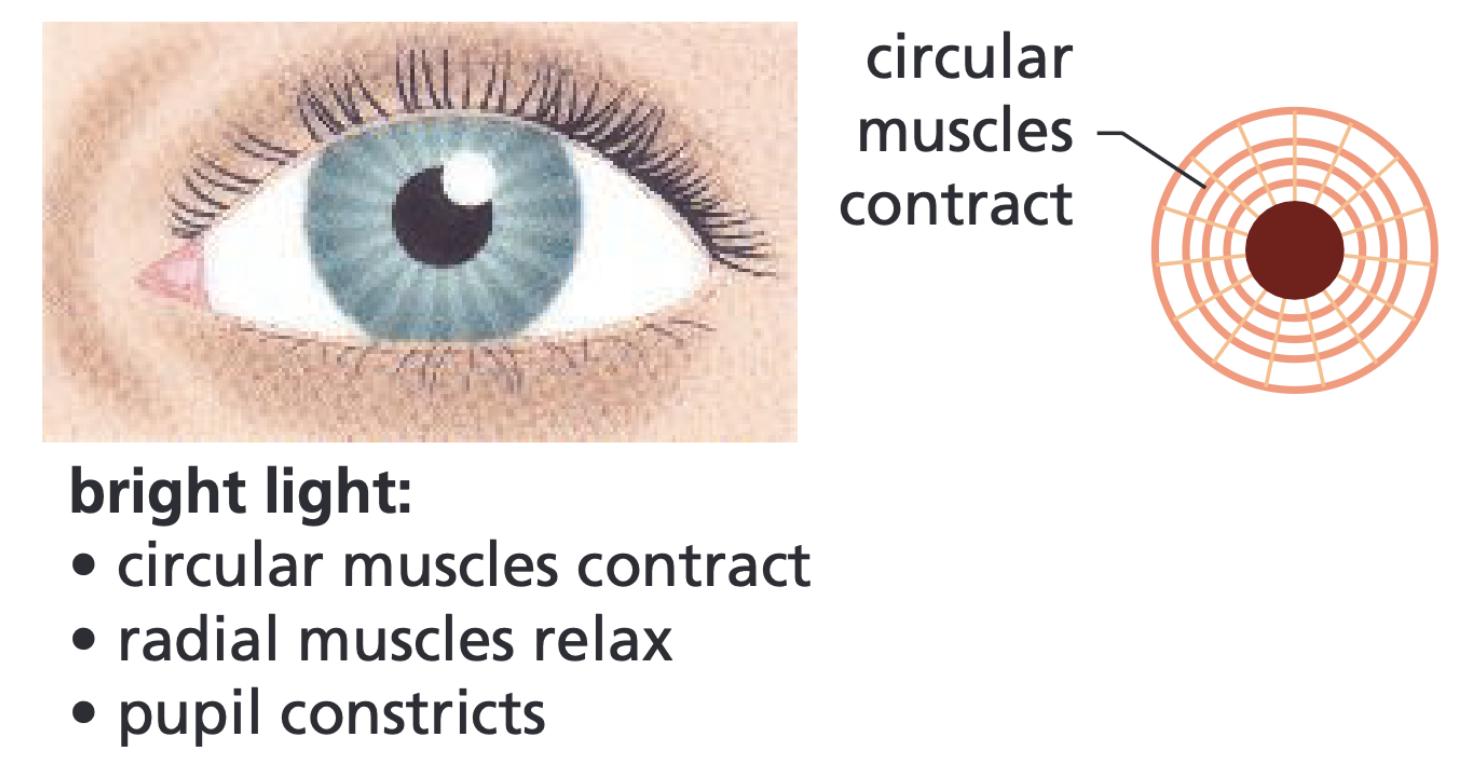
What is the role of the suspensory ligaments and ciliary muscles
To alter the shape of the lens and hold it in place. The lens helps to fine tune the focussing of the light rays, and produce a clear image on the retina
What is the role of the jelly in the eye
The eye is filled with thick transparent jelly, which keeps the spherical shape of the eye and helps to focus the light
What is the role of the retina
The retina contains millions of receptors sensitive to light intensity and colour. When light hits these retina, the light sensitive receptors are stimulated, and an electrical impulse is sent through sensory neurones in the optic nerve to the brain, which interprets them as a visual image
What is the role of the optic nerve
Sends electrical impulses from the retina to the brain, which can interpret them to produce a visual image
Where is the blind spot
Where the optic nerve leaves the eye, as the eye has no retina, but the brain fills it in so we are often unaware of it
What is accommodation
Accommodation is the process of changing the shape of the lens to focus on near or distant objects.
How does the lens help us see clearly
It focuses the light rays, changing their direction, to produce a clear image on the retina. This changing of direction of the light is called refraction.
Why is the shape of the lens changed
The lens changes shape to ensure the light rays are focussed onto the retina. If they focus in front or behind the retina the image will be blurred. The light is focussed by the lens through the process of refraction.
What happens in the eye to focus on a near object
To focus on a near object:
the ciliary muscles contract so the diameter of the muscles is smaller
the suspensory ligaments loosen
the lens is then thicker and refracts light rays strongly.
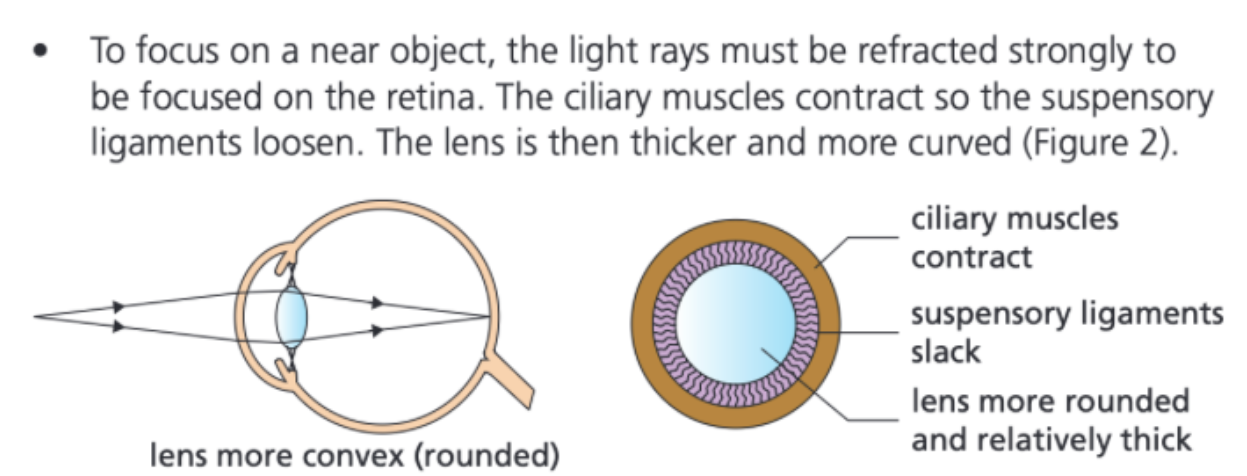
What happens in the eye to focus on a distant object
To focus on a distant object:
the ciliary muscles relax, so the diameter of the muscles is larger
the suspensory ligaments are pulled tight
the lens is then pulled thin and only slightly refracts light rays.
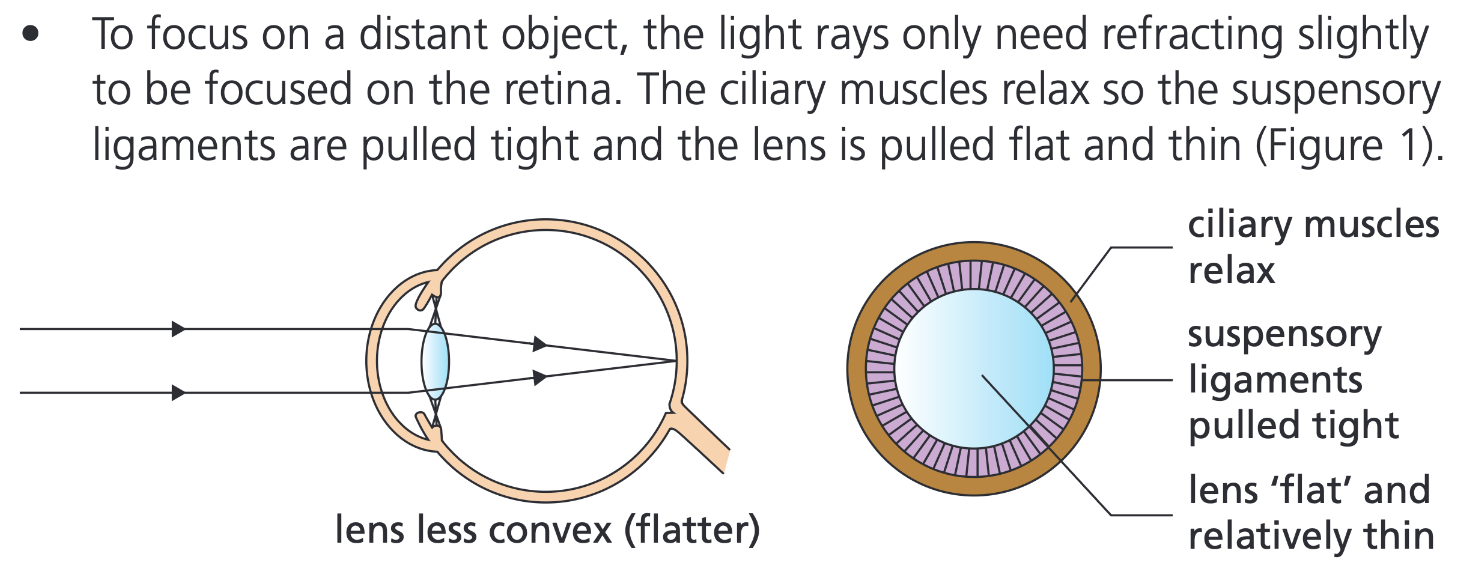
What are the two common eye defects
Myopia (short-sightedness)
Hyperopia (long-sightedness)
What is myopia and how can it be treated
Myopia is when close objects can be seen clearly, but far away objects are blurry. This happens because the light focuses in front of the retina, meaning the image is blurry. This may happen because the lens is too curved, or the person has a particularly long eyeball. This can be treated using glasses with a concave lens, which spreads out the rays so they focus on the retina

What is hyperopia
Hyperopia is when distant objects can be seen but not close ones. This happens because the light focuses behind the retina, meaning the image is blurry. This may happen because the lens is too flat or thin, or the person has a particularly short eyeball; this means that the lens can’t refract the rays of light strongly enough. This can be treated using glasses with a convex lens, which bring the rays closer together, so they can be focussed on the retina
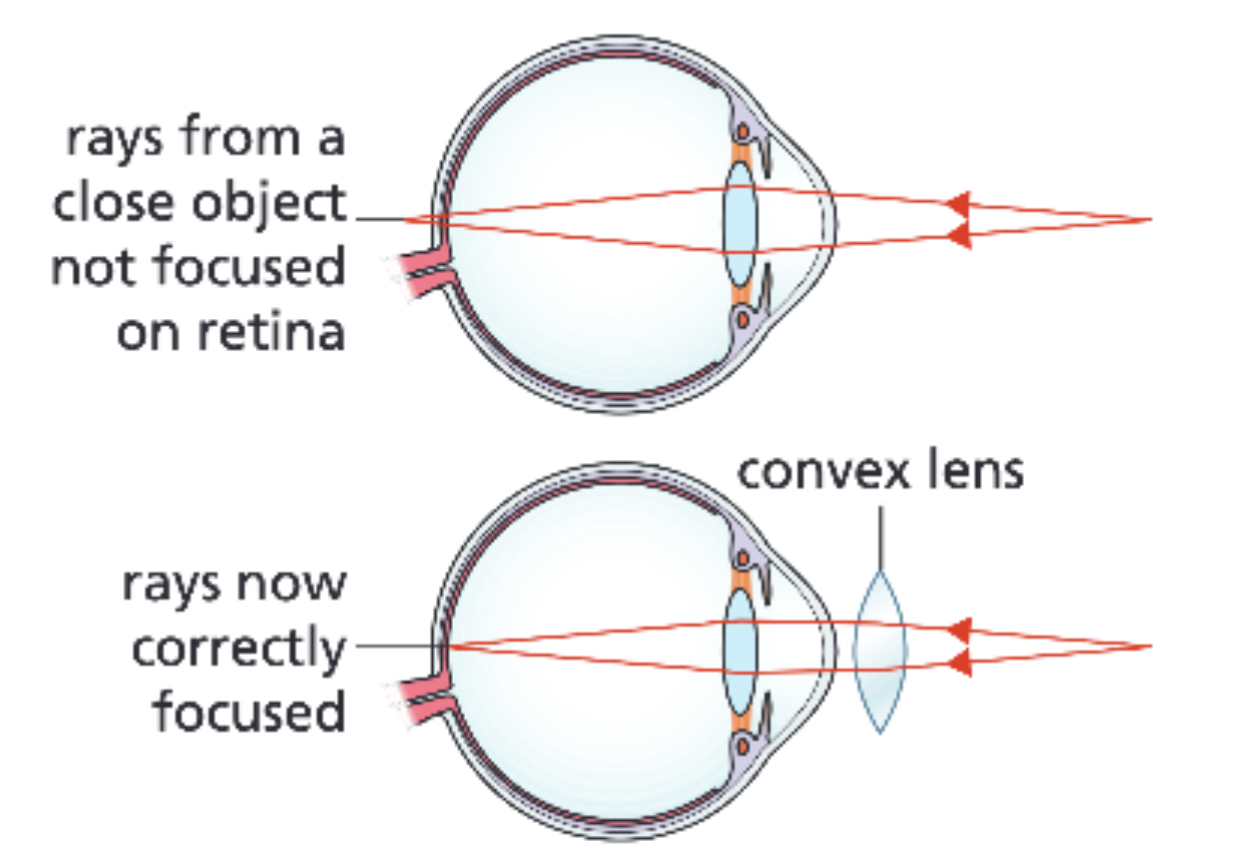
What are some new technologies for treating eye diseases
Soft and hard contact lenses
Laser eye surgery- used to thin the lens for myopia, and change the curve of the lens for hyperopia
Replacement lens- either an artificial lens implanted into the eye, or the lens is replaced by an artificial lens
What is the endocrine system
The endocrine system is composed of glands which secrete chemicals called hormones directly into the bloodstream. The blood carries the hormone to a target organ where it produces an effect. Compared to the nervous system the effects are slower but act for longer.
Draw and label the main glands on the human body
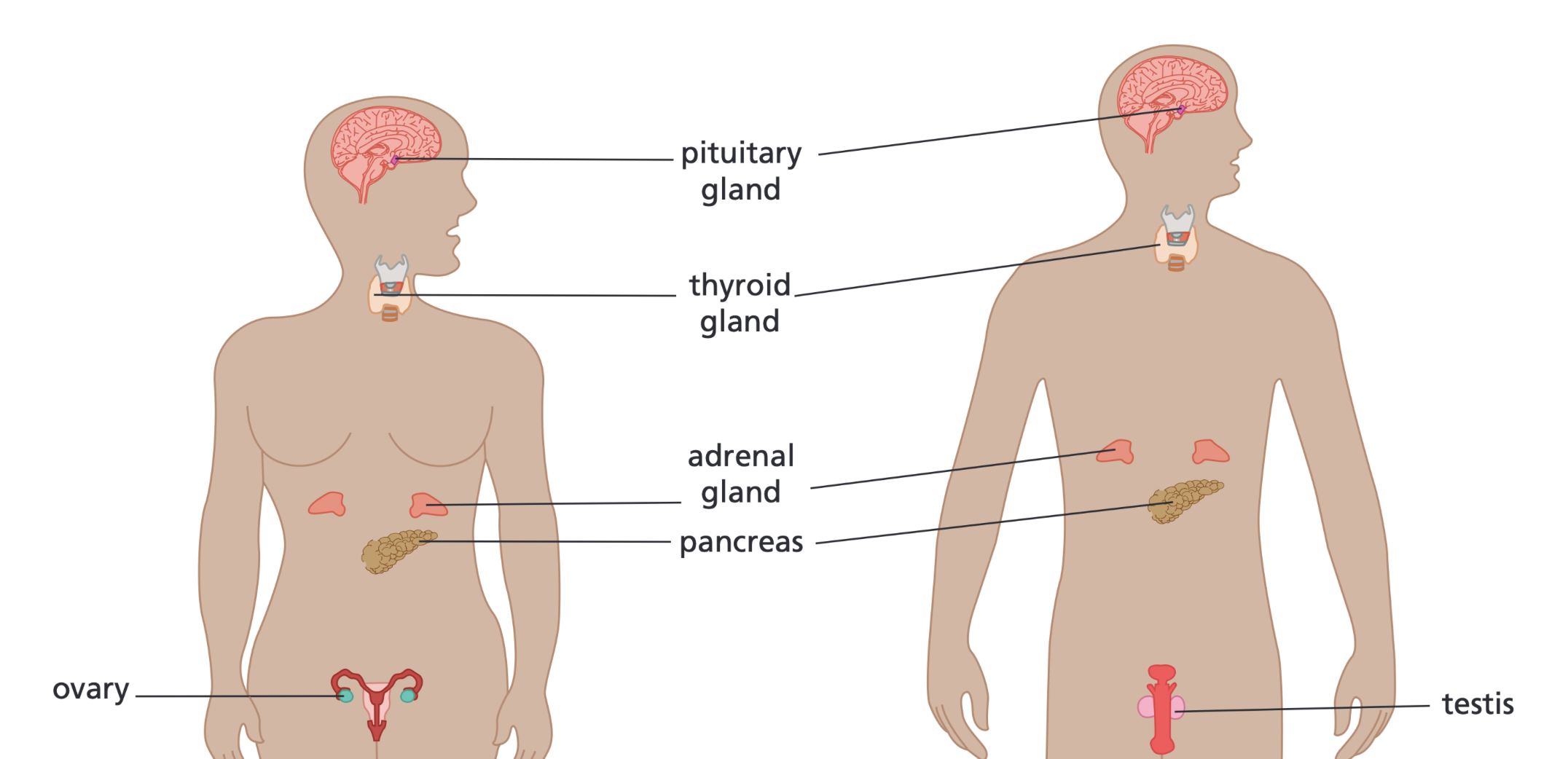
What is the role of the pituitary gland
The pituitary gland in the brain is a ‘master gland’ which secretes several hormones into the blood in response to body conditions. These hormones in turn act on other glands to stimulate other hormones to be released to bring about effects.
Which hormones are produced by the pituitary gland
ADH
Growth hormone
TSH- stimulates the thyroid gland
FSH
LH
Which hormone is produced by the thyroid gland
Thyroxine- controls the basal metabolic rate of the body
What hormone is produced by the adrenal glands
Adrenaline- prepares the body for stressful situations- fight or flight response
Which hormone is produced by the pancreas
Insulin- controls the levels of glucose in the blood
What happens when blood glucose levels are too high
If the blood glucose concentration is too high, the pancreas produces the hormone insulin that causes glucose to move from the blood into the cells. In liver and muscle cells excess glucose is converted to glycogen for storage
What is type 1 diabetes
Type 1 diabetes is a disorder in which the pancreas fails to produce sufficient insulin. It is characterised by uncontrolled high blood glucose levels, glucose in the urine, tiredness, and lack of energy, and is normally treated with insulin injections.
It is caused by genetics, and will usually develop in childhood, teen or early adulthood
What is type 2 diabetes
In Type 2 diabetes the body cells no longer respond to insulin produced by the pancreas. A carbohydrate controlled diet and an exercise regime are common treatments. Obesity is a risk factor for Type 2 diabetes, and is more common as age increases
What happens if blood glucose levels are too low
If the blood glucose concentration is too low, the pancreas produces the hormone glucagon that causes glycogen to be converted into glucose and released into the blood
What is negative feedback
In negative systems, whatever the initial change, the response causes the opposite change. Hormones such as insulin and thyroxine are involved in negative feedback
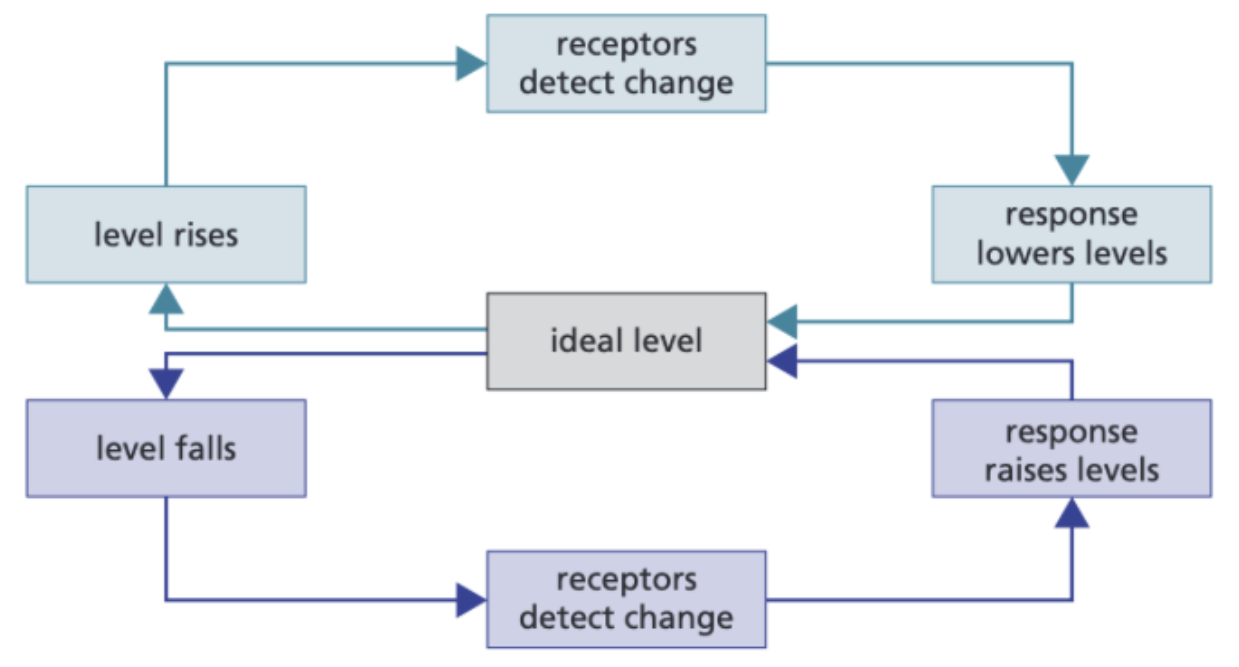
How is the negative feedback cycle used by the pancreas
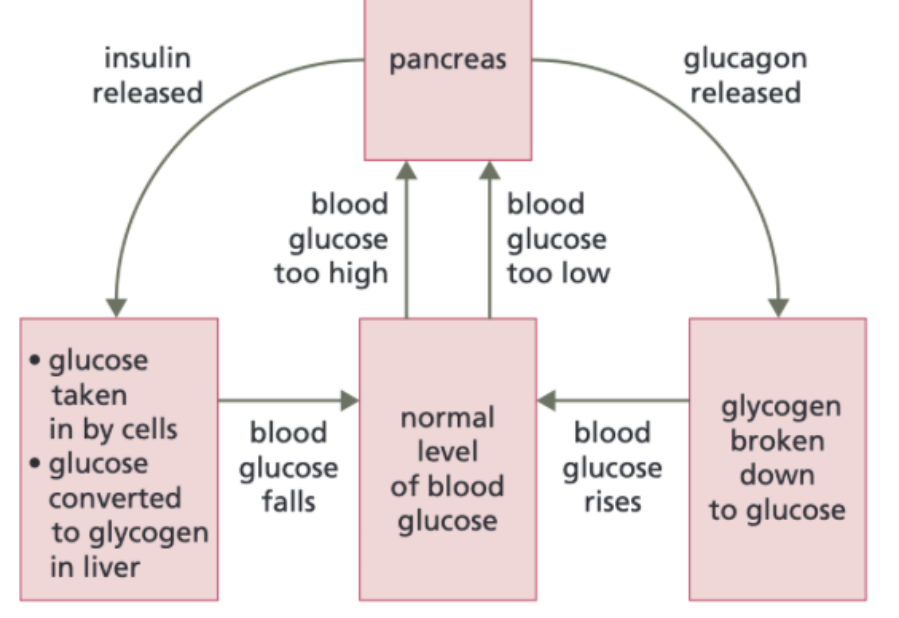
What is thyroxine, and how is negative feedback used by the thyroid gland
Thyroxine from the thyroid gland stimulates the basal metabolic rate. It plays an important role in growth and development.
if the levels of thyroxine begin to fall, it is detected by sensors in the brain
the pituitary gland produces more TSH
the TSH stimulates the production of thyroxine in the thyroid gland
as the levels of thyroxine go up, it is detected by sensors in the brain
so the pituitary gland produces less TSH
What is adrenaline and how is used in the body
Adrenaline is produced by the adrenal glands in times of fear or stress. It increases the heart rate and boosts the delivery of oxygen and glucose to the brain and muscles, preparing the body for ‘flight or fight’.
What happens during puberty
During puberty reproductive hormones cause secondary sex characteristics to develop.
What is oestrogen
Oestrogen is the main female reproductive hormone produced in the ovary
What is ovulation
At puberty eggs begin to mature and one is released approximately every 28 days. This is called ovulation.
What is testosterone
Testosterone is the main male reproductive hormone produced by the testes and it stimulates sperm production
Which hormones are involved in the menstrual cycle
Follicle stimulating hormone (FSH) causes maturation of an egg in the ovary.
Luteinising hormone (LH) stimulates the release of the egg.
Oestrogen and progesterone are involved in maintaining the uterus lining.
What happens to women during puberty
Growth spurt
Hair growth under arms. and pubic hair
Breast development
The external genitalia grow and the skin darkens
Adult female body develops
Brain structures changes and matures
Eggs start to mature every month in the ovaries
Uterus grows and menstruation begins
What happens to men during puberty
Growth spurt
Growth of hair under arms, pubic hair, facial hair
Larynx gets bigger and voice breaks
External genitalia grow and skin darkens
Adult male body shape develops
Brain structure changes and matures
Testes grow and become active, producing sperm throughout life
What is the role of FSH in the menstrual cycle
FSH is secreted by the pituitary gland
In females it makes eggs mature in their follicles in the ovaries
It also stimulates the ovaries to produce hormones, such as oestrogen
What is the role of LH in the menstrual cycle
LH is secreted by the pituitary gland
It stimulates the release of a mature egg from the ovary
Once ovulation has taken place, LH levels fall again
What is the role of oestrogen in the menstrual cycle
Oestrogen is secreted by the ovaries, in response to FSH
It stimulates the uterus lining to grow again after menstruation, in preparation for pregnancy
High levels inhibit the release of FSH and stimulate the release of LH
What is the role of progesterone in the menstrual cycle
Progesterone is secreted by the empty egg follicle after ovulation by the ovaries
It helps to maintain a pregnancy after an egg has been fertilised
It maintains the uterus lining in the second half of the cycle
It inhibits both FSH and LH
What happens if the egg is not fertilised
The levels of all the hormones drop, and the lining of the uterus pulls away and is lost from the body. After this, a new lining develops, and the levels of FSH and progesterone rise
Draw graphs to represent the levels of each hormone on each day

How does the combined pill work as a contraceptive
Contains hormones (like oestrogen and progesterone) which inhibit FSH production- this means that no egg matures, preventing pregnancy
They also prevent the uterine lining from developing, preventing implantation, and making the cervical mucus thicker, to prevent sperm getting past
Easy to use but must be taken regularly
Side effects- higher risk of high blood pressure, blood clots and breast cancer
An alternative to this is the progesterone only pill, which has fewer side effects, but is much more important to be taken regularly because body hormones will quickly return to normal, potentially causing unexpected pregancy
How do implants, injections and patches work as contraceptives
injection, implant or skin patch of slow release progesterone to inhibit the maturation and release of eggs for a number of months or years
Implants last 3 years and are 99.95% effective
Injections last about 12 weeks
Patch lastes 7 days
How do barrier methods work as contraceptives
Provide a barrier to prevent sperm from getting to a mature egg once its been released by the ovary
Condom is a thin latex sheath placed over the penis before intercourse, to collect the semen and prevent the sperm from reaching the egg
There are no side effects to this, and don’t require medical advice, but can split, be damaged and let sperm through by mistake
A diaphragm is rubber cup placed over the cervix before intercourse to prevent the sperm from reaching the egg
Like condoms they have no side effects, but must be positioned by a doctor initially, as if it is misplaced, it could let sperm through
All barrier methods have spermicides on them, which kill or disable sperm
How does an Intrauterine Device (IUD) work as a contraceptive
Small structures, implanted by a doctor, shaped like a hook, which lasts 3-5 years
Can be removed at any time
Copper IUDs work by preventing a fertilised egg from implanting in uterus
Progesterone IUDs work by preventing the build up of the uterine lining by releasing hormones, meaning eggs can’t implant
Very effective but can cause period problems and infections
How can abstinence or the rhythm method work as contraceptives
No sex= no pregnancy
Rhythm method works by abstaining from sex when the egg is released (ovulation) or in the oviduct to prevent pregnancy- no side effects but very unreliable
How do surgical methods work as contraceptives
Males- vasectomy
Sperm ducts are cut (cauterised) or tied to prevent sperm from exerting the semen
Women- oviducts are cut or tied to prevent egg from reaching uterus and therefore egg from reaching sperm
Effective permanent contraceptives but require anaesthetic
Describe how fertility drugs can be used as fertility treatment
If a woman’s pituitary gland does not produce enough FSH, the egg won’t mature, causing infertility
Synthetic FSH and LH are used in fertility drugs to overcome the problem
Synthetic FSH increases the amount of FSH in the body, allowing eggs to mature and stimulating the production of oestrogen
Synthetic LH can trigger ovulation to allow the woman to get pregnant naturally
This must be monitored to make sure the woman does not release too many eggs in a cycle
How does In Vitro Fertilisation (IVF) work as a fertility treatment
IVF involves giving a mother FSH and LH to stimulate the maturation of several eggs.
The eggs are collected from the mother and fertilised by sperm from the father in the laboratory.
The fertilised eggs develop into embryos.
At the stage when they are tiny balls of cells, one or two embryos are inserted into the mother's uterus (womb).
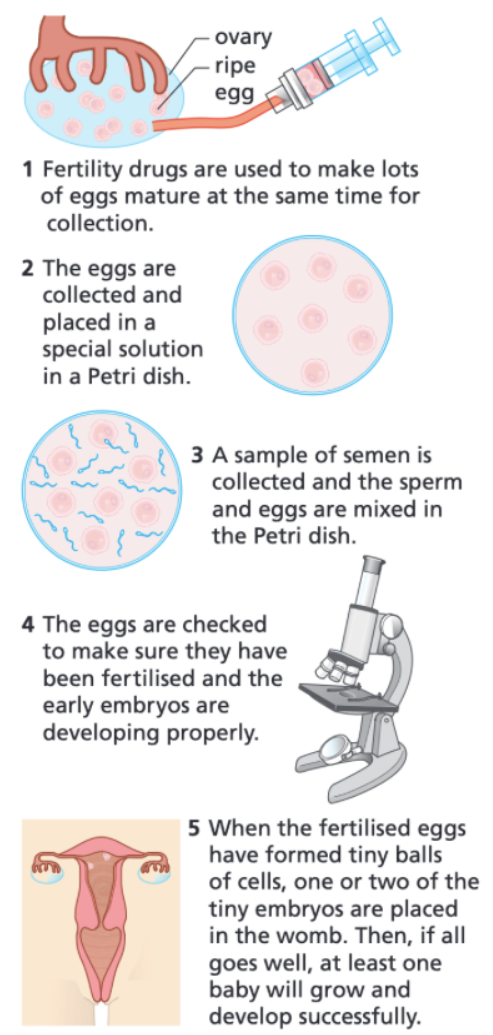
What are the advantages of fertility treatment
Gives people who are otherwise infertile the chance to have a child
Success rate increases with donor eggs or sperm
Not all embryos are used immediately, so can be frozen and used later on if children are wanted later
What are the disadvantages of fertility treatment
Success rates are not high- the older parents are, the lower the chances
Process is physically stressful and fertility drugs can provide health risks
Emotionally stressful for parents
Higher chance of multiple births for IVF, which can cause stillbirths, premature births and disabilities- this had. reduced in recent years as tighter restrictions on IVF in the UK
Very expensive for NHS or person if they pay for it (thousands of pounds per cycle of IVF)
Ethical issues of the use of leftover embryos- if they are discarded or used in stem cell research, is this a waste of life? if the partners split or up, or one of them dies, who has ownership of embryos
How is body temperature controlled and monitored by the body
Body temperature is monitored and controlled by the thermoregulatory centre in the brain. The thermoregulatory centre contains receptors sensitive to the temperature of the blood. The skin contains temperature receptors and sends nervous impulses to the thermoregulatory centre.
What happens if body temperature is too high
If the body temperature is too high, blood vessels dilate (vasodilation) and sweat is produced from the sweat glands. Both these mechanisms cause a transfer of energy from the skin to the environment.
Vasodilation means the blood vessels which supply the skin surface capillaries dilate (note- capillaries do not dilate, as they have no muscle) which means more blood through these capillaries and to the skin surface, which increases the temperature of the skin to allow some of the heat energy to be radiated to the surrounding and cool down the body
When you sweat, you cool down, as the water evaporates, transferring some of the energy to the surroundings- in humid weather this doesn’t work as well. The water and mineral ions lost from sweat must be replaced by eating and drinking to replace the loss
What happens if body temperature is too low
If the body temperature is too low, blood vessels constrict (vasoconstriction), sweating stops and skeletal muscles contract (shiver).
Vasoconstriction means the blood vessels supplying the skin surface capillaries constrict (note- capillaries do not constrict, as they have no muscle) which means less blood through these capillaries and to the skin surface, which reduces the amount of energy lost to the environment by radiation
Sweat production stopping means less water from sweat evaporates and transfers energy to the surroundings
Shivering of the skeletal muscles involves muscle contraction and relaxation rapidly, so constant respiration, an exothermic reaction, which releases energy, and so warms up the body
What is the effect on cells from osmotic changes
If body cells lose or gain too much water by osmosis to the fluids surrounding them, they do not function efficiently.
What are some uncontrolled ways of removing waste products
Water leaves the body via the lungs during exhalation.
Water, ions and urea are lost from the skin in sweat.
There is no control over water, ion or urea loss by the lungs or skin.
How is excess water and minerals removed in controlled ways
Water and ions are removed in the urine via the kidneys